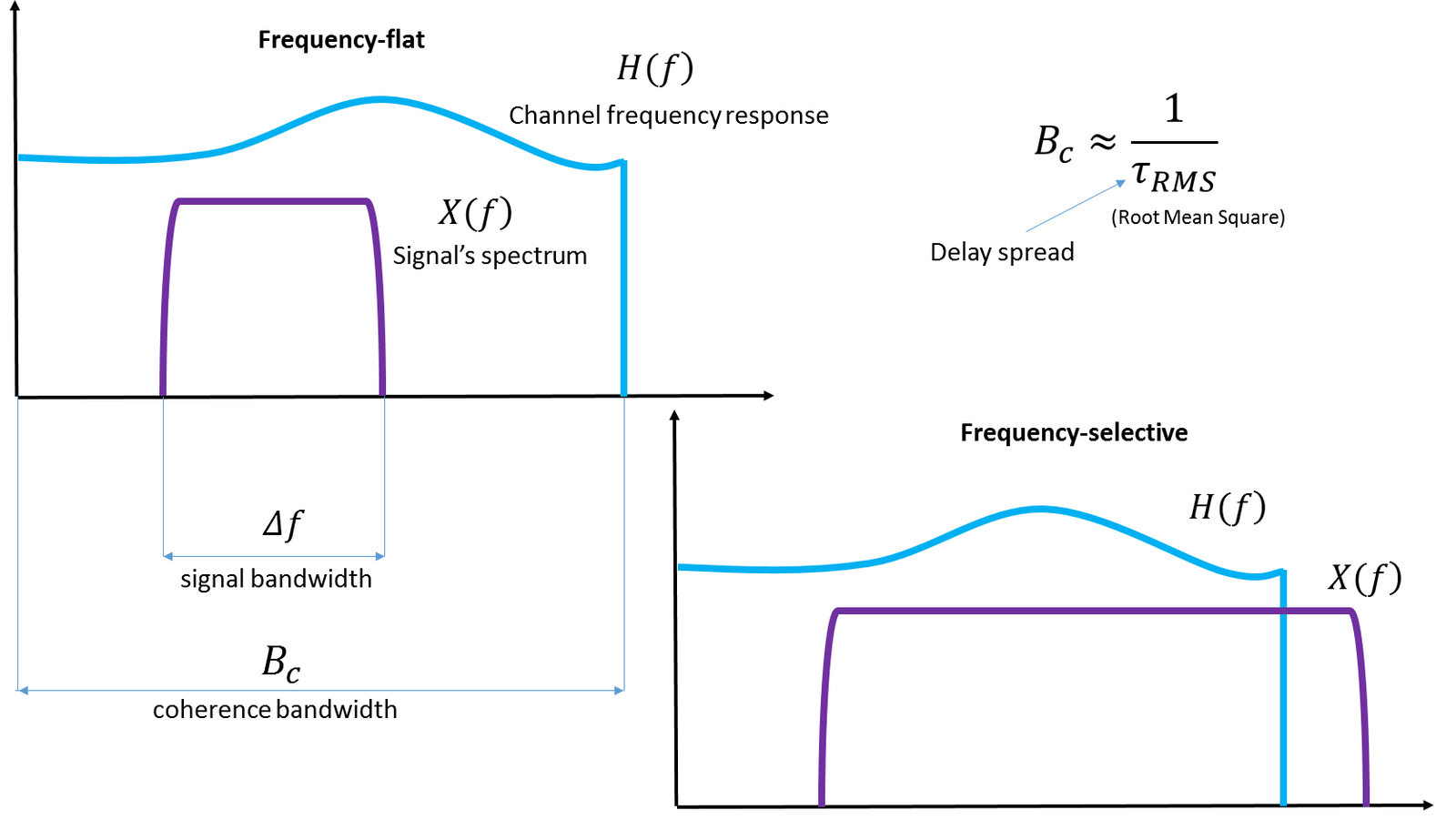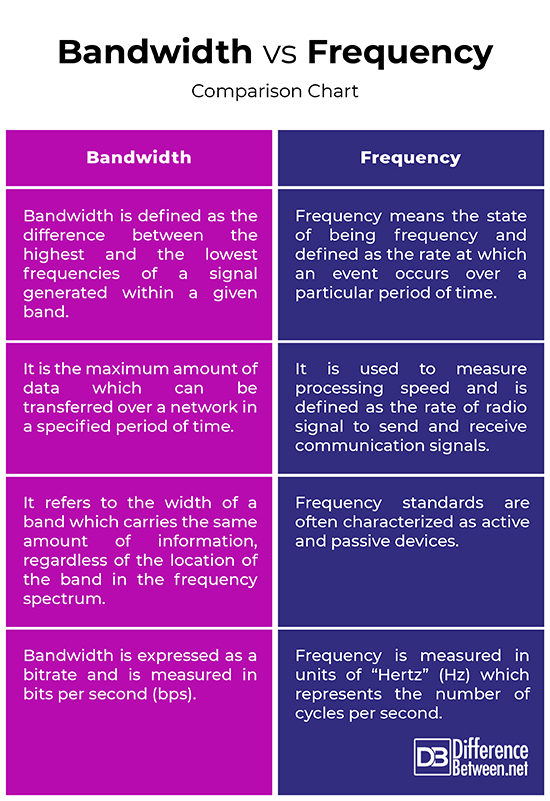Difference Between Bandwidth and Frequency
A radio signal does not carry a single frequency. In fact, it uses a range or band of frequencies to convey the actual sounds. The only signal that could be carried at a single, pure frequency would be an unvarying tone. The bandwidth of the signal is the size of the frequency band – that is, the difference between the top and the bottom frequencies of the band. The frequency of a signal describes how many signals go past a certain point in a specified period of time.

What is Frequency?
Frequency is the state of being frequent. It is defined as the number of times an event occurs in a specified amount of time. For example, if you visit a supermarket thrice a week, your shopping frequency is three visits per week. Frequency can be used to measure the rate of any action or event. In fact, frequency represents a standard measurement quantity, the one that can be determined by far the highest degree of accuracy. The speed of a vehicle is determined by time or frequency measurement. However, other quantities like magnetic fields or electric voltages or wireless communications can be directly related to frequency measurement. In the networking world, frequency is used to measure processing speed and is defined as the rate of radio signal to send and receive communication signals. In the internationally adopted system of units, the frequency is measured in units of “Hertz” which represents the number of cycles per second.

What is Bandwidth?
Wireless communications are typically performed within a constrained set of frequencies known as a frequency band. This frequency band is the bandwidth. The term bandwidth is used informally to mean amount of information communicated per second. Well, in technical terms, bandwidth is a range of frequencies within a given band, particularly used for transmitting a signal. The range of frequencies which build up a given signal is called signal bandwidth. In simple terms, bandwidth is defined as the difference between two values of frequencies, i.e., the difference between the highest and lowest frequency components. Let’s say, if you choose two points on the frequency scale as f1 and f2, then the bandwidth is given by f2 – f1 in Hertz or Hz. A voice signal does not contain one unique frequency but consists of waveforms of different frequencies, which makes it difficult to predict the exact frequency of the signal. So, we define a bandwidth for voice signals instead where bandwidth is defined as the difference between the highest and the lowest frequencies in the signal.
Difference between Bandwidth and Frequency
Definition
– Both frequency and bandwidth are the measuring units of networking. The basic difference between the two is that frequency is defined as the rate of radio signal to send and receive communication signals, whereas bandwidth is defined as the difference between the highest and the lowest frequencies of a signal generated. In technical terms, bandwidth is a range of frequencies within a given band, particularly used for transmitting a signal. Frequency, on the other hand, is the number of cycles or oscillations that occur in a signal per second. Frequency helps to calculate bandwidth.
Measurement
– Frequency can be used to measure the rate of any action or event. In fact, of all the measurement quantities, frequency represents the one that can be determined by far the highest degree of accuracy. In the internationally adopted system of units, the frequency is measured in units of “Hertz” which represents the number of cycles per second. Bandwidth, on the other hand, is the amount of data that can be transferred from one point to another in a specified amount of time within a network. Bandwidth is expressed as a bitrate and is measured in bits per second (bps).
Characteristics
– There are certain terms like precision, stability, and accuracy that are often used to characterize the quality of a frequency standard. Frequency standards are often characterized as active and passive devices. A stable frequency source on its own, however, doesn’t yet represent a frequency standard. It is necessary that the frequency is known in terms of absolute units. Bandwidth, on the other hand, refers to the width of a band which carries the same amount of information, regardless of the location of the band in the frequency spectrum.
Bandwidth vs. Frequency: Comparison Chart

Summary of Bandwidth vs. Frequency
The capacity of a radio channel depends on the frequency at which messages are transmitted and the amount of power used to transmit them. Because the capacity depends on the frequency bandwidth, the term bandwidth is informally defined as the amount of information communicated per second. But technically, bandwidth is the size of the frequency band, which is the difference between the highest and the lowest frequencies of the band. So, channel capacity is proportional to bandwidth of the signal. Frequency, on the other hand, is used to measure processing speed and is defined as the rate of radio signal to send and receive communication signals. Frequency standards link the different areas by using a common unit, the hertz.
- Difference Between Caucus and Primary - June 18, 2024
- Difference Between PPO and POS - May 30, 2024
- Difference Between RFID and NFC - May 28, 2024
Search DifferenceBetween.net :
Leave a Response
References :
[0]Coleman, David D. and David A. Westcott. CWNA: Certified Wireless Network Administrator Official Study Guide: Exam CWNA-106. Hoboken, New Jersey: John Wiley & Sons, 2014. Print
[1]Furht, Borko. Encyclopedia of Multimedia. Berlin, Germany: Springer, 2008. Print
[2]Hura, Gurdeep S. and Mukesh Singhal. Data and Computer Communications: Networking and Internetworking. Boca Raton, Florida: CRC Press, 2001. Print
[3]Abelson, Harold et al. Blown to Bits: Your Life, Liberty, and Happiness After the Digital Explosion. Boston, Massachusetts: Addison-Wesley, 2008. Print
[4]Riehle, Fritz. Frequency Standards: Basics and Applications. Hoboken, New Jersey: John Wiley & Sons, 2006. Print
[5]Image credit: https://commons.wikimedia.org/wiki/File:Coherence_bandwidth.png
[6]Image credit: https://commons.wikimedia.org/wiki/File:Frequency_rate_chart_example.jpg
